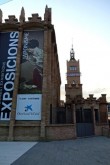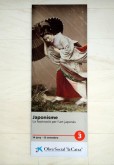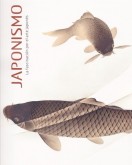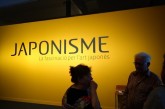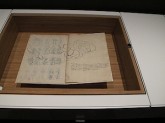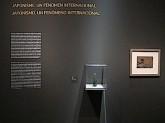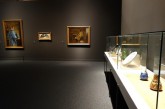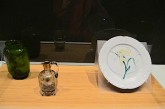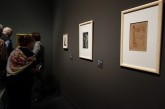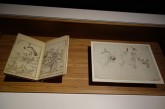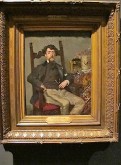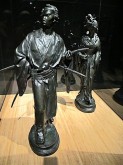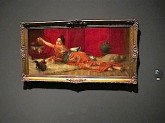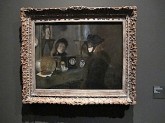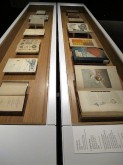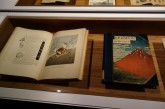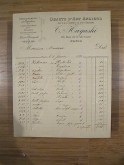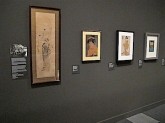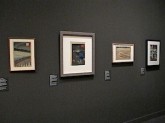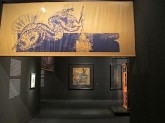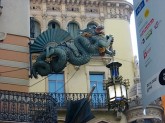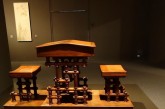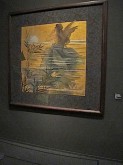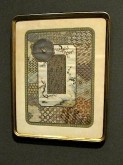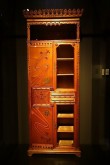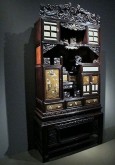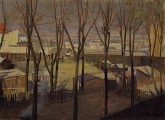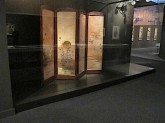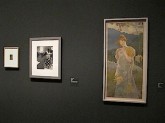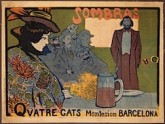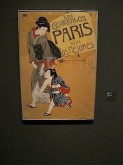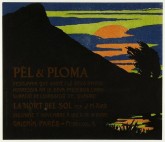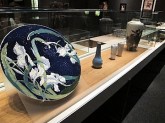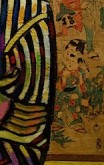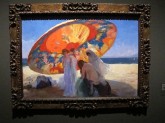The browser will either open the file, download it, or display a dialog.
Japonismo: La fascinación por el arte japonés
CaixaForum Barcelona
June 14 – September 15, 2013
CaixaForum Madrid
October 17, 2013 – February 16, 2014
Curator: Ricard Bru i Turull
Catalogue:
Japonismo: La fascinación por el arte japonés.
Japonisme: La fascinació per l'art japonès.
Edited by Ricard Bru i Turull; essays by Bru i Turull, Fernando García Gutiérrez, S. J., Akiko Mabuchi, Teresa-M. Sala; entries by Bru i Turull, Eliseo Trenc, Pilar Vélez, and others.
Barcelona: Obra Social “la Caixa,” 2013.
248 pages; 347 color illustrations, 9 b&w; bibliography; checklist.
€35
ISBN: 978-84-9900-082-4 [Castilian]
978-84-9900-083-1 [Catalan]
In mid-June 2013, the first exhibition in Spain on international Japonisme opened in Barcelona’s CaixaForum and traveled in October to the CaixaForum in Madrid for a second, four-month showing. The bank “La Caixa” opened its new cultural center in Barcelona in 2002 at the foot of Montjuic, an area rebuilt for the 1929 world’s fair with the vast Palau Nacional (now the National Museum of Catalonian Art) crowning the hilltop. The bank had purchased, restored, and redesigned a long-abandoned textile factory completed in 1911 for the manufacturer Casimir Casaramona by the architect Josep Puig i Cadafalch (fig. 1).[1] In this masterpiece of industrial architecture, Obra Social “la Caixa” mounted its Japonisme show between the original iron columns and under the beams of a spacious upstairs gallery.
The poster advertising the exhibition was a detail of a hand-colored albumen print from the collection of Hermenegildo Miralles (1859–1931), the renowned Barcelona bookbinder and publisher (fig. 2). Only about 8 x 10 inches, this print of Woman in the Rain is now preserved with the rest of the Miralles collection in the National Library of Catalonia.[2] It is one of nearly 300 objects gathered in 2013 to reconstruct the appeal of Japan for artists, collectors, and a broad public around the turn of the previous century. The photograph, dating from the 1870s, was the work of an Austrian working in Yokohama, Baron Raimund von Stillfried, who sold his stock of glass negatives to Kusakabe Kimbei in the 1880s when he left the country. Through the enlargement of this work combining two of the most familiar symbols of Japan – the oiled paper umbrella and the kimono – today’s exhibition visitors were summoned to explore a little known ingredient in the exhilarating brew of Catalan culture during the decades before and after 1900.
The young scholar Ricard Bru i Turull organized this groundbreaking investigation of the fascination for Japanese art.[3] For the covers of his superb exhibition catalogue, Bru chose a resonant national symbol of strength and persistence: the carp (fig. 3). The immediate source of the image was one of a pair of rare porcelain plates on display in the show, produced in 1887 by the Asahi Yaki Tokyo workshop headed by Gottfried Wagener (1831–92).[4] The carp motif was based on an eighteenth-century hanging scroll (kakejiku) by Maruyama Ōkyo. The two porcelain plates were first shown in Barcelona at the Japanese pavilion in Ciutadella Park built for the universal exposition in 1888.
The Japanese carp or koi became an invasive species in the European decorative arts after the universal exposition in Paris in 1867. There the designer Eugène Rousseau exhibited an innovative earthenware dinner service with a décor based on Japanese drawings and prints. To manufacture the “service Rousseau,” he collaborated with Félix Bracquemond, who produced etchings for transfer printing on faience fine. For the fish plates, Bracquemond adapted a drawing from volume 13 of the Manga of Katsushika Hokusai (or his school), inspired perhaps as well by a woodblock print by Katsushika Taito II.[5] European carp based on Hokusai won further acclaim at the next Paris world’s fair in 1878. Like Bracquemond, Emile Gallé and Eugène Rousseau removed the well-camouflaged figure of Kannon from the carp’s back for their remarkable glass vases. Gallé sold his carp vase to the Musée des Arts Décoratifs in Paris after the exhibition, and Rousseau’s was acquired by the Baltimore collector Henry T. Walters.[6]
Wagener’s workshop manufactured the porcelain plates in Tokyo specifically for Spain’s first international exposition in 1888. That world’s fair, Bru emphatically states in a catalogue essay, was “the key to the consolidation of Japonisme in the peninsula and especially in Barcelona” (119).[7] The selection of the carp details for the front and back catalogue covers in 2013—the larger fish’s tail ends within the front flap—was a reference to the role of porcelain in stimulating patronage and profit at the fair. It is typical of the thoughtful design and pertinent content of the exhibition book.[8] Object details in the front matter, printed in subtle colors on both sides of four double-folds of Japanese paper, lure the reader into the catalogue. The carp scales in low relief on the covers add a tactile pleasure to the visual presentation of material inside, where every object in the show is described in entries initialed by the authors.
Entering the exhibition gallery the viewer could pause at an unobtrusive wall text outlining the scope of the show and the breadth of its material, much of it presented for the first time. The narrative path proceeded past the title of the show on sunny yellow panels leading into the first room (fig. 4). That initial gallery—“The discovery of Japan”—was dedicated to the earliest contacts with Spain. From 1549, when the first missionaries landed in Kagoshima on Kyushu with the Jesuit saint Francis Xavier, until 1624, when Spanish ships could no longer dock in Japanese ports, the first western art objects arrived and cultural exchanges took place.[9] Within white table-like vitrines, each manuscript or book fit into a custom-tailored recessed space. A codex of a text by Marco Polo (Biblioteca Capitular Colombina, Seville) was the first item in the show; the Venetian traveler had recorded the name of the islands as Cipango.[10] A map by Abraham Ortelius including the name Japan stood next to the codex: Theatrum Orbis Terrarum (1570, Biblioteca Nacional de España). The third object was a curious late sixteenth-century balloon or bubble map drawn by persecuted Christians for a bishop in the Philippines, an early graphic representation of the Japanese provinces (fig. 5).[11]
The Japonisme exhibition had been scheduled in the context of the four hundredth anniversary of the embassy sent in 1613 by Date Masamune, the daimyō of Sendai, to the Spanish court and to Pope Paul V Rome.[12] The daimyō’s letter to the city of Seville, delivered on October 27, 1613, by his ambassador, the samurai Hasekune Tsunenaga, was displayed in a vitrine adjacent to a Japanese samurai helmet given to King Philip III of Spain. The samurai envoy converted to Christianity in Madrid—the Duke of Lerma was his godfather—and returned to Japan as the persecution of converts peaked.[13]
Even the relatively open-minded daimyō Date Masamune yielded to the demands of the Tokugawa shogun to get rid of Christians. A seventeenth-century bronze fumi-e (step-on picture) in the exhibition represented the images of the Virgin that those suspected of Catholic sympathies were required to trample (32–33). Remarkably, the Jesuit church of Il Gésu in Rome lent to the Barcelona venue of the show its delicate Martyrdom in Nagasaki, painted in Macao a few years after the executions in the autumn of 1622. Twenty-five missionaries, including the first ordained Japanese Jesuit, and scores of other Christians died at the stake or by decapitation. Fearing a conquest as in Latin America, the shogun closed all the country’s ports to the Spanish, and diplomatic relations would not resume until more than two centuries later. As the last object in the initial room, the depiction of the violent rupture with Spain set the scene for the mid-nineteenth century. Japan’s isolation until the reopening of its ports to foreign trade and the fall of the Tokugawa shogunate in 1868 contributed to the feverish nature of its rediscovery by Europeans, the subject of the second gallery.
The initial treaty with the United States in 1854 was signed in Kanagawa, now a ward of Yokohama and the name of its province. The copy of the agreement in English (National Archives, Washington), opening two coaling ports to American steamships, bears no Japanese signature: it was illegal for a subject of the emperor to sign a document in a foreign language. Similar treaties were concluded during the 1850s between Japan and Great Britain, France, and Russia, and the agreement with the United States was extended to include commercial trade. The first treaty with Spain was signed in Kanagawa on November 12, 1868. By then, Japanese woodblock prints had been displayed at the universal exposition of 1867 in Paris. Kanagawa soon became better known through the title of a work in the series Thirty-Six Views of Mt. Fuji by Katsushika Hokusai: Under the Wave off Kanagawa. A Czech designer, Adolph Beckert, paid homage in 1905 to Hokusai’s masterpiece with a glass vase, now in the Museo Nacional de Artes Decorativas in Madrid (42). The Beckert vase launched the show’s second section, “Japonisme, an international phenomenon,” and next to it hung an impression of the Hokusai print acquired by the Catalonian national museums from a private collector in 1916 (fig. 6).
Heading the Japanese delegation to the exposition in 1867 was the shogun’s half-brother, Tokugawa Akitake, who turned fourteen in Paris. A few days after the fair closed in November, the shogun was forced to resign, marking the end of Tokugawa reign. The Meiji period (meaning “enlightened rule”) began in 1868, under an emperor only a year older than the Tokugawa prince in Paris. Akitake had remained in Europe after the exposition to study languages, fencing, and art. His drawing master, James Tissot, signed and dedicated a watercolor portrait of Akitake on September 27, 1868 (43). Tissot’s painting, on view in the second gallery of the show, is preserved in the Tokugawa Museum, Mito. It has returned to Europe only once before, when it was lent in 1988 to the Japonisme show in Paris and Tokyo.
One of the essayists for the exhibition twenty-five years earlier, Mabuchi Akiko, also contributed to the CaixaForum catalogue (33–41).[14] In her essay Mabuchi explores the question, how did Japonisme come about? Why, she asks, wasn’t it born in Holland, with its continual trade from Dejima, off Nagasaki, during the two centuries that Japan was closed to other European ships? She sees another necessary condition, apart from intriguing objects to serve as models, in the growing desire among European artists in the late nineteenth century to find vigorous new forms. Differentiating two broad and sometimes overlapping tendencies within the phenomenon of Japonisme, Mabuchi describes first a trend toward exoticism, akin to orientalism, in those artists searching for motifs to be expressed realistically. Others pursued a second tendency to assimilate from Japanese art new means of transforming subject matter through elevated points of view, cropping, or broad masses of color. An enticing theme, the woman in kimono, flourished in the hands of both tradition-bound artists and innovators. Tissot, for example, depicted Japanese garments worn by models to enhance collectors’ items or as an attractive furniture cover. The flood of goods from the East offered a wealth of material. The Belgian Alfred Stevens, whose lovely Japanese Parisienne (ca. 1872, Musée d’Art Moderne et d’Art Contemporain, Liège) hung in the show between small works by Giuseppe de Nittis and Edouard Manet, also painted canvases loaded with imported objects, pictures that resembled stage sets (fig. 7).[15] A history painter like Georges Rochegrosse, not usually thought of as a Japoniste and not included in the show, could achieve strikingly pared-down results in his studio full of Japanese props: Self-portrait (1885–86, Musée Anne-de-Beaujeu, Moulins).[16]
Although a handful of European artists traveled to Japan once the period of isolation ended, Mabuchi denies that their documentary exactitude can be considered Japonisme (39).[17] She sees the artists who studied objects in Europe—listing Manet, Edgar Degas, Claude Monet, or Vincent van Gogh among the most valuable players—as more profound contributors to the movement than the voyagers. An equal star among printmakers, Félix Buhot, copied in a series of etchings around 1875 works from the collection of Philippe Burty, the critic who gave a name to the new movement in 1872.[18] The Buhot portfolio, published in 1883, targeted elite enthusiasts; the title page hung in the exhibition. An indispensable intaglio print by Henry Somm in the second room of the show embodied another aspect of this early phase.[19] Somm had studied Japanese in Paris and illustrated several articles for Burty. At the center of Somm’s Japonisme (1881; private collection) is a modish young Frenchwoman, seemingly in a reverie induced by a pair of string-bound picture books (e-hon). Standing on an album under the eaves of a lakeside pavilion is a miniature Japanese man holding a fan and a bamboo lantern pole. Another man, half hidden by the books, has brought a cup of tea, and beyond the girl’s heavily inked bonnet ribbon small figures walk on a distant shore.[20] Her fantasies suggest the enchantment with Japan that overcame Paris following the 1878 exposition. Such flights of the imagination could have been nurtured by curio shops or the department store displays of bibelots mentioned by Emile Zola in Le Bonheur des Dames (1883). The use of the Somm drypoint in the show acknowledges the commercial aspects of the rage for Japanese art and its rapid spread in memes for the middle class consumer along with the connoisseur.
In the second stage of Japonisme, the basis for art nouveau and further developments in the twentieth century, Mabuchi finds “no geishas or samurai, no pine trees, no cranes.” (41). Instead, artists – notably graphic artists – integrated sinuous forms of colorful garments, diagonal lines, and empty spaces into their compositions. Strong examples of this second tendency in the show – absorbing the vision of Japanese art without its costumes and props – were two posters by Henri de Toulouse-Lautrec: Divan Japonais (1892) and Jane Avril (1893), both in impressions from the Victoria and Albert Museum, London. They bear an unmistakable stamp of Japan without specific borrowings, although photographs exist of Toulouse-Lautrec himself wearing a kimono (50-51).
Appropriating Japanese sympathy for nature, Western artists found a boundless source of renewal, particularly in the decorative arts. On display were examples of artists’ integration of animals and plants, as in Gallé’s Oakleaf Vase, a Baccarat footed flacon, or Bracquemond’s narcissus plat rond in faience fine on a white ground from the “Service with Flowers and Ribbons” produced from his etchings in 1879 (fig. 8).[21] Three vases formerly in the collection of the Barcelona designer and marquetry master Gaspar Homar, including a Royal Copenhagen porcelain vase with dragonflies, offered a glimpse at objects inspiring Homar’s furniture and his stunning dragonfly ceiling lamp on view in later rooms of the show (fig. 9).[22] Two pencil drawings by Henri Gabriel Ibels were acquired by the Catalan artist Santiago Rusiñol and are preserved in his home Cau Ferrat in Sitges. Described by Bru as a drawing clearly showing the influence of Japanese prints, the small, impressive Harlequin by Ibels hung as the last work on paper in the second section (fig. 10). It served as an example of how Japonisme spread when artists and designers returned from Paris to their home countries. Two paintings from the 1890s – both by relatively little known artists and standing for parallel trends of Japonisme – marked the end of the international chapter of the show (fig. 11). Charles Guilloux was a self-taught master of symbolist landscape, now ripe for rediscovery.[23] His riverscape from 1894, almost a foot square, adapts Japanese vision without overtly referring to sources. In his blue hour on the banks of the Seine at Saint Denis, the only crane in sight is the strong diagonal of the hoisting device on the foreground barge. A final landscape by Georges Ferdinand Bigot in the form of a kakejiro falls into the category of documentary Japonisme. His distant view of Mt. Fuji seen from Awashima was painted in Japan. He framed the sacred mountain with pine branches and included a staffage figure in native dress. Earning his living as an illustrator, Bigot remained in Japan for seventeen years and – less surprisingly than Toulouse-Lautrec – was also photographed in a kimono.
The third section of the exhibition—“The arrival of Japonisme in Spain” —introduced the Catalan painter Mariano Fortuny. As Mabuchi noted in her essay, Fortuny was crucial in the transmission of Japonisme from Paris to his homeland (41). Like so many others, Fortuny copied Hokusai’s Manga; a vitrine displayed the double page from Hokusai beside the Spanish artist’s sketches from about 1870 (fig. 12). A major painting by Fortuny, The Children of the Painter in the Japanese Salon (1874, Prado, Madrid), was seen only in the Madrid venue of the show. Begun in August 1874 in a rented villa in Portici shortly before the artist died from malaria in October, the canvas shows his daughter, Maria Luisa, stretched out on a long, upholstered divan. She sleepily wields a decorated fan and leans on a scarlet cushion embroidered with cranes. Her brother, Mariano, sits to her left, looking down at the richly embroidered blue fabric that partly covers his bare body. In one of his last works, the painter recorded his three-year-old son’s precocious fascination with colorful fabrics. The child, now as famous as his father, was the fashion designer Mariano Fortuny y Madrazo. The canvas by the elder Fortuny came to the Prado in 1950 as a bequest after his son’s death the previous year in Venice. In this unfinished and personal picture, Fortuny began developing compositional ideas derived from the Japanese artists he admired (74–5).
A close painter friend of Fortuny’s, Eduardo Zamacois, also died young. Originally from Bilbao, Zamacois introduced Fortuny in Paris to his American patron, William Hood Stewart.[24] A French colleague, the illustrator Henri Pille, depicted Zamacois with a cigarette, seated beside a small table with a portable altar and ceramics from his collection (fig. 13). In the catalogue essay accompanying this section, Bru lists some twenty-five Spanish painters who, in the wake of Fortuny, introduced Japanese objects into their paintings (65). He notes that the first shop selling Japanese art opened in Madrid in 1874, and the first railroad line between Barcelona and Paris opened four years later, coinciding with the world’s fair of 1878 in the French capital. A Catalan sculptor, Justo Gandarias, sent a bronze Japonesa to the Paris exposition, encouraged by the sale of a Japanese couple dated 1875 to the Spanish royal family (fig. 14). Gandarias was one of only three sculptors identified by Bru as contributing significantly to Spanish Japonisme (84).
Around 1880, the Seville-born artist José Villegas Cordero, later director of the Prado, painted a studio kimono picture: Oriental Games (fig. 15). Against a dramatic red screen, he staged an improbable but very Japanese cockfight on a polar bear rug, adding a round lacquered cage and an incense burner to his exotic décor. Hanging nearby in the exhibition was After the Ball by Francesc Masriera. His picture focuses on a disconsolate young woman, who apparently had little success with her kimono. She is comforted by two friends in European historical costumes (fig. 16). This bourgeois interior not only documents the state of the fad in Barcelona by 1886, it also presents the painter for the first time in the show. Masriera was one of three brothers from a prominent family of jewelers – Francesc, Josep, and Frederic – described by Bru as essential promotors of Japonisme in Catalonia through their activities as collectors (86–7). The next Masriera generation could be seen in several outstanding works later in the exhibition by Lluis Masriera, Francesc’s nephew and Josep’s son.
A painting installed between the Masriera and the Villegas kimono pieces illuminates, however dimly, a quite different interior. Darío de Regoyos painted Portrait of Miss Jeanning in London in 1885 (fig. 17). He merges in this canvas an inventory of Japanese artifacts with an inventive format, a London twig of Japonisme that might be tagged Whistlerian.[25] Regoyos visited James McNeill Whistler in London in September 1885, along with the Belgian poet Emile Verhaeren and the painter Willy Schlobach, who was born in Brussels to German parents. Miss Jeanning, in fact, is thought to be a model of Whistler’s.[26] As Bru remarks, Regoyos was one of the most cosmopolitan Spanish painters of the nineteenth century, and both his Japonisme and his Neo-Impressionism took shape in Belgium.[27]
The section entitled “Trade and collecting” began in a small adjacent room. There a double vitrine held books, journals, and documents pertinent to the eruption of Japonisme in Spain through print media and commerce (fig. 18). A copy of the first volume of L’Art Japonais (1883) by Louis Gonse opened the display. Formerly owned by the multitalented Catalonian artist and intellectual Alexandre de Riquer, the book was opened to show Philippe Burty’s Crabe (enter “98” in search box on link), a woodblock print by Kunisada Toyokuni I (fig. 19). Next to the Gonse book was a bound second volume of Siegfried Bing’s Le Japon artistique (1888–89). Bing’s monthly journal was put to use in Catalonia, much as he had intended, as a visual encyclopedia for artists, collectors, and artisans. A competitor to Bing in the commercial dispersal of Japanese objects in Europe was Tadamasa Hayashi (1853–1906). Among the documents in the vitrine was a bill from his Paris establishment to “Monsieur Mansana” for the purchase of a painting by Katsushika Hokutei (fig. 20). The Barcelona collector Josep Mansana Dordan and his son Josep Mansana Terrés traveled regularly to Paris after an initial misadventure with some fake lacquer work in 1885. Their private collection of Japanese art became the largest in the country, encompassing some 3,200 objects.[28] Bru devotes a short catalogue essay to the development of the Mansana collection (182–5).
The equally ambitious Masriera family collection was installed after 1884 in a studio that resembled a Greek temple. Constructed by the architect Josep Vilaseca, it opened to the public in 1913 as a museum with a published catalogue. The exhibition visitor at the CaixaForum a century later stepped out of the small room with books and documents into a dazzling assembly of Masriera treasures, including a seventeenth- to eighteenth-century gilded and lacquered wooden Buddha (Shaka Nyorai) and an embroidered silk tapestry, now in private hands. Moving past a splendid kimono once owned by the author and graphic artist Apel·les (or Apeles) Mestres, a katana (sword) that had belonged to the stage designer Oleguer Junyent, and a suit of samurai armor, the museum-goer could examine a photograph of the Mansana collection in 1927 (fig. 21). Next to it was a yotaka (low-ranking prostitute) painted by Katsushika Hokutei, the work listed on Hayashi’s bill from 1890. In the poem accompanying the image, Bru explains, the young woman’s father praises his hard-working daughter (96–7). With an eighteenth-century lacquer box by the Rinpa artist Ogata Kōrin, as well as a Tōshūsai Sharaku woodblock print of a Kabuki onnagata (actor of women’s roles) displayed next to the painting, the exhibition demonstrated the quality of the Mansana holdings.
A spectacular album of 109 surimono, specially commissioned woodblock prints with poetry, occupied much of a vitrine; it had been in the collection of the painter Joaquín Sorolla. Unfolded to Utagawa Kuniyoshi’s Ichikawa Danjuro VII in the role of Benkei fighting Yoshitsune (ca. 1830) and Totoya Hokkei’s The Poetess Ono no Komochi (ca. 1820), and other prints, the album provided a hint of the Valencian painter’s exposure to Japanese art. The woodblock prints in this gallery had been selected not only for their quality and familiarity, but because they had been collected by leading Spanish artists (fig. 22). Alfred Sisquella had owned Rain Falling on the Bridge at Atake, and Alexandre de Riquer had acquired the impression of Aoi Slope, both from Hiroshige’s One Hundred Famous Views of Edo. The Santiago Rusiñol collection included the same woodblock artist’s Morning Snow at Yoshiwara from Famous Views of the Eastern Capital. At the end of the room a painting by Rusiñol dated 1894 hung next to a gold-ground screen painting of a daimyo’s procession. Rusiñol’s interior of his recently acquired house in Sitges, Cau Ferrat, shows his daughter standing near the screen. Bru calls the picture, “a clear example of the interactions that took place between the artists of the late nineteenth century and their collections of Japanese art” (94–5).
A banner based on the zinc dragon on the Casa Bruno Cuadros, the former umbrella and fan shop opposite the Gran Teatre del Liceu on the Rambla, marked the entrance to the next section: “Aestheticism” (figs. 23, 24). This room gave a vivid picture of 1880s Barcelona: graphic art by Apeles (or Apel·les) Mestres, tapestry-like painted panels by Alexandre de Riquer, and furniture from the studios of Josep Vilaseca, Gaspar Homar, Francesc Vidal and his business partner Frederic Masriera. The architect Vilaseca completed remodeling the premises for the umbrella merchant just before the international exposition in 1888, and some of his shop furnishings survive (fig. 25).[29] The remarkable artist Riquer was represented by three of eight decorative panels created in 1887 for a Barcelona dentist; all eight are preserved in the Museu Nacional d’Art de Catalunya (MNAC), Barcelona (fig. 26). Eliseu Trenc pointed out in his entry for the three paintings that Riquer had traveled to Paris in 1879 and again in 1885. He suggests that on the second trip the artist acquired his copy of Louis Gonse’s l’Art Japonais seen earlier in the exhibition. Trenc calls the nymph panel more eclectic than the vertical paintings, whose flat and stylized treatment of the plants unmistakably reflect Japanese sources (110–11).[30] Bru described Gaspar Homar in the exhibition catalogue as one of the furniture makers most interested in Japanese art (108). He turned eighteen in September 1888, the year of the Barcelona international exposition, when he painted the watercolor displayed in this room (fig. 27). An impressive armoire made around 1891 testified to his maturity as a craftsman in his early years in the studio of Francesc Vidal (fig. 28).
Another banner spanned the entrance to the next important chapter of the exhibition and catalogue: “Japan in the Exposición Universal of 1888.” The banner reproduced a photograph of the Japanese pavilion, one of the most visited at the fair; its exhibitors took home twenty-three gold medals, a proportion of awards equal only to Belgium. Bru outlines the role of the Japanese delegation in his catalogue essay, underlining the importance of the semi-public arts and industries agency responsible for introducing products to the West, the Kiriu Kōshō Kaisha. The first shop in Barcelona specializing in Japanese art, El Mikado, had opened in 1885, and its owner, Ot Vinyals, moved and expanded his business just before the exposition. Vinyals signed agreements with the Kiriu in 1888 that permitted direct imports from Japan to Barcelona (118–23).[31]
The Kiriu presented an elaborate shodana made by its craftsmen to Queen Regent Maria Cristina, a gift from the Imperial family (fig. 29). Before the 2013 show, the elaborate display cabinet had not previously left Barcelona city hall for an exhibition. Captivated by Japanese art and curios, the queen allowed herself and her son, the future King Alfonso XIII, to be photographed around 1894 in kimonos. Reassembled as hanging scrolls, these fragile works hung in this section to suggest the impact of the fair. Materials related to the Japanese interpreter for the delegation in 1888, Kume Keiichiro, a young art student in Paris, were displayed in a vitrine, and a nude painted by Kume in 1889 was lent to the show by the Kume Museum of Art in Tokyo. One of several other Meiji artists who sent works to Barcelona in 1888, Ōsawa Nankoku, was represented in the 2013 show with four paintings on silk.[32]
Accompanying the rich penultimate chapter of the exhibition –“Japonisme and modernisme, a symbiosis”– was a catalogue essay by Teresa-M. Sala (127–31). She sees an early call for modernity in an article on Apeles Mestres that appeared on April 25, 1889, in the new series of the journal L’Avens (the name, meaning “progress,” was changed in 1891 to the orthographically correct L’Avenç). Only a few months after the international exposition closed, the author Josep Roca y Roca noted the marvelous Japanese works in the Mestres residence and ended by quoting the artist’s credo: “I believe in nature!”[33]
In October 1890, a trio of artists held the first of their eleven joint exhibitions in the Sala Parés in Barcelona. Teresa Sala notes that with this show Rusiñol, Ramon Casas, and the sculptor Enric Clarasó, introduced the public to modern Catalan painting (129). Rusiñol had experienced his first stay in Paris in 1889, the year of the next universal exposition, and in the summer of 1890, he moved into the Moulin de la Galette with Casas and Miquel Utrillo. La Butte, a Rusiñol landscape of Montmartre, appropriately launched the section on the symbiosis of Japonisme and modernisme in the 2013 Barcelona show (fig. 30). The exhibition label reproduced Hokusai’s View from Hodogaya on the Tōkaido Route, and Isabel Coll’s catalogue entry notes that Rusiñol found in the woodblock print a means to break with conventional composition schemes (134). Similarly, Regoyos derived from Japanese works on paper his typical elevated viewpoint seen in another landscape in this section, The Urumea River (1904; Museo de Bellas Artes de Bilbao), as mentioned in the catalogue entry by Mikel Lertxundi Galiana (146–7).
The jeweler, painter, stage designer, and director Lluis Masriera inherited a love of Japanese art from his father, Josep Masriera, and his uncle Francesc. He painted the exhibited screen of a sunrise with flamingos, plants, and butterflies when he was not yet twenty, in the earliest years of what came to be called modernisme in Barcelona (fig. 31). Aside from the putto in the first panel, his Japonisme in the screen resembles imported Meiji art. Although the young Masriera had studied in Paris – and trained as well in enamelwork in Limoges and Geneva – his paintings, unlike contemporary works of Rusiñol and Utrillo, bear few shadows of Montmartre. Utrillo, by contrast, carried a strain of Parisian Japonisme back to his home city, and Riquer, as Eliseu Trenc has pointed out, conveyed strong traces of the poster artists he admired or collected, namely the Belgian Henri Privat Livemont or the American Ethel Reed (fig. 32).[34] Trenc called the chrysanthemum, a motif repeatedly used by Riquer, the “Japanese flower par excellence” (150). In a catalogue entry on the cover of Riquer’s book of symbolist poetry and on his watercolor Chrysanthemums (both 1899), Aitor Quíney comments on the influence of katagami on the graphic arts (152).[35]
Utrillo and Casas created the poster Sombras for their beer hall Els Quatre Gats, the center for a few years of Catalan modernisme (fig. 33). The image refers to the shadow plays they had imported from their old Paris haunt, the cabaret Le Chat Noir, which closed in 1897, the year that Els Quatre Gats opened. Eliseu Trenc points out in the exhibition catalogue another French import in this section (fig. 34). Not only the brand name of the cigarette – Paris – relied on French allure, Trenc comments, but the design submitted by P. Tera to the firm’s poster contest copied Siegfried Bing’s cover for the February 1889 number of Le Japon artistique (150). Tera replaced the woman’s umbrella with a Paris cigarette and eliminated the boy’s kite and puppies. Bing’s reproduction was itself an altered version of a print by Torii Kiyonaga. Periodicals such as Luz and Pèl & Ploma, as David Almazan discusses in an entry on several Catalan journal covers, used increasingly advanced lithographic and photomechanical techniques (154). Almazan observes that, as in the final issue of Luz for 1898 displayed in the exhibition, journals began to consider their graphic content as important, if not more important, than their articles. A lithograph for Pèl & Ploma by Josep Maria Xiró offered a good example of the state of the art in printing and of the transformation of Japanese sources in Catalan art after the turn of the twentieth century (fig. 35). The same sort of advances in ceramics were demonstrated in the exhibition by a vitrine of faience, including the magnolia vase and other works of Antoni Serra i Fiter from his workshop in Barcelona (fig. 36).
Three models from the 1880s by the stage designer Fèlix Urgellès from the Institut del Teatre, Museu de les Arts Escèniques, one replicating the interior of a mausoleum at Nikko, introduced a small section on the theater. Near the models of stage sets hung portraits by Casas and Pablo Picasso of the Japanese actress Sadayakko. She toured Europe after her appearance with Loie Fuller at the Exposition Universelle in Paris in 1900, performing in Barcelona in May 1902. In an alcove at the 2013 exhibition, three short movies by the Spanish filmmaker Segundo de Chomón played continuously, introducing the visitor to his wonderful Les Ki-ri-ki Acrobates japonais of 1907. Finally, in this section the brilliant sculptor Francisco (Paco) Durrio was present with the silver pendant Birds and three brooches, while jewelry by Lluis Masriera was shown adjacent to an anonymous drawing from his family collection based on their own album by Hiroshige.
More surprises awaited the visitor in the final chapter of this beguiling exhibition: “The enduring popularity of Japonisme.” A gouache screen with vaguely oriental figures and lanterns from about 1918–23 was attributed to Salvador Dalí. Two Noh masks once owned by Lluis Masriera (now in the Museu Etnològic of Barcelona) were mounted over a vitrine with material concerning his theatrical productions: a comedy Okarū from the early 1920s and Fantasia Japonesa a decade later. The designer Mariano Fortuny y Madrazo’s nineteenth-century Noh kimono stood with a Cristóbal Balenciaga dressing gown from 1920 in kimono style. An expressive school of Barcelona lacquer work, seen in screens by Ramon Sarsanedas, updated Japonisme in the Art Deco style. These late manifestations of the trend and the Spanish discovery of origami and haiku in the 1920s are discussed in an essay by Ricard Bru (189–93). One of the aficionados of haiku was the graphic artist Enric Cristòfol Ricart, as Bru mentions in his entry for the portrait made in 1917 by Joan Miró, a close friend (212). Although Miró did not travel to Japan until his exhibition in 1966 and again in 1969, the painter had first shown his interest in Japan in this portrait of Ricart, where he affixed an actual woodblock print and signed the canvas vertically in a cartouche imitating that of the Japanese artist (fig. 37). The portrait, lent by the Museum of Modern Art in New York, brought to mind one of the early works in the show, the drypoint Japonisme (1881) by Henry Somm. The frontal figure of Ricart fills Miro’s canvas, and behind him are miniature Japanese, as in Somm’s reverie of a Parisian consumer. Ricart’s pose is also reminiscent of van Gogh’s Portrait of Père Tanguy (1887, Musée Rodin, Paris); Auguste Rodin, another woodblock print collector, bought the van Gogh in 1894. Miro painted Ricart in 1917, the year Rodin died. The fascination with Japanese graphics was still potent in a Europe devastated by war.[36]
The Miró portrait was the last painting in the show, after the Dalí screen. Another late example of Catalan Japonisme, however, occupied a prime spot in this final row. It was the work of Lluis Masriera, heir to the Masriera collection and to the family’s enduring attraction to Japan (fig. 38). His many versions of Sombras Reflejadas (1920) were based on a large parasol his father, Josep Masriera, had purchased in April 1904; the shop bill was included in the exhibition. Bru ends his catalogue entry on the painting with an anecdote reported by Lluis Masriera (215). A friend traveling in Japan brought the artist a copy of the painting on a Japanese fan. “It was quite exact,” Masriera said, “except the Japanese artist had covered up the nudes with kimonos.”
Lluis Masriera once stated that modernisme had died in 1910. Artists called modernistas – particularly architects – tended to disavow the label. Puig i Cadafalch, for example, who was the architect of the building that housed Els Quatre Gats, as well as of the Casaramona factory where the Japonisme show took place, claimed in 1902 that a modernista building had yet to be built.[37] The upcoming movement called noucentisme waited in the wings to exact a classical vengeance. Yet modernisme survived as a portmanteau term for the vibrant creative life in urban Catalonia around 1900, or as a mere translation of art nouveau, especially in the decorative arts.
The Obra Social “la Caixa” exhibition made visible the quest for renovation in Japonisme as a thread in modernisme, while giving equal time to more conservative impulses and to the sheer joy in Japanese objects. The show and catalogue told the story well, and Ricard Bru and his team deserve warm praise for a nuanced presentation of so much new material. The catalogue is a pleasure to hold. Each chapter starts with a stunning enlarged detail on a double spread, with a vertical inset near the gutter for the chapter title. Hokusai, of course, opens three of the chapters, and surfing the Wave off Kanagawa is an unforgettable treat (33–34). Plus, each time you close the covers, there are those caressable carp.
Jane Van Nimmen
Independent scholar, Vienna, Austria
vannimmen[at]aon.at
[1] Francisco Javier Asarta, Roberto Luna, and Robert Brufau completed the restoration and remodeling of the brick and iron factory. The new entrance of the CaixaForum with its metal tree and sunken terrace are the work of the Japanese architect Arata Isozaki, best known for his Gunma Museum of Modern Art in Takasaki (1970s, extended in 1994). Isozaki’s Qatar National Convention Center in Doha (2011) also incorporates tree forms.
[2] The Metropolitan Museum of Art, New York, included another albumen print from this glass negative in its recent exhibition, “Faking It: Manipulated Photography before Photoshop” (October 11, 2012–January 27, 2013). The print was on loan from the collection of Howard Greenberg.
[3] His dissertation, a meticulous study of the roots of Japonisme in Barcelona, was published in 2011; see Ricard Bru i Turull, Els Orígens del japonisme a Barcelona: la preséncia del Japó a les arts del viut-cents (1868–1888) (Barcelona: Institut d’Estudis Món Juïc, 2011).
[4] Wagener was a Prussian scientist who arrived in Japan in 1868, the year the Meiji period began. After building the first coal-fired kiln in the porcelain town of Arita, he taught in Tokyo after 1870. He traveled to Vienna with the Japanese delegation to the world exposition in Vienna in 1873 and again to Philadelphia for the Centennial Exposition in 1876. At his death Wagener was director of the ceramics section of the arts and crafts school, now Tokyo Institute of Technology. The second Wagener porcelain plate in the 2013 exhibition, also dated 1887, depicted wild ducks.
[5] On this early example of Japonisme in ceramics, see Jean-Pierre Bouillon, Art, industrie et Japonisme: le service “Rousseau,” Les Dossiers du Musée d’Orsay 20 (Paris: Réunion des musées nationaux, 1988). Between 1873 and 1875, the Sèvres porcelain decorator Henri Lambert exhibited in Paris another service in fine faience produced by Eugène Rousseau, including an extraordinary fish plate. On Lambert, see Gabriel P. Weisberg, “Japanese Art on a Plate: An Unknown Masterpiece of French Ceramic Design,” Apollo (September 1, 2006), 36–43.
[6] The carp in the “large fish” series by Utagawa Hiroshige was also a model for Western artists. Rousseau’s vase may have taken additional inspiration from Carp and Water Plants by Utagawa Toyokune I or another Taito woodblock print, later immortalized in a reproduction on the cover of the December 1889 issue of Siegfried Bing’s Le Japon artistique. After the Vienna world’s fair in 1873, paper carp streamers (koinobori) were a source of fascination in European displays on Japan.
[7] See Bru 2011 (as in note 3), 439–699, for an exhaustive study of the impact of the international exposition in 1888.
[8] The graphic designer Lali Almonacid and Edicions 62 were credited with the design and editorial coordination of the Japonisme catalogue.
[9] The development of Namban (or Nanban) art produced through contacts with the “southern barbarians” – the Portuguese and the Spanish – is discussed in a catalogue essay by Fernando García Gutiérrez, S. J., “Introduction to the Culture and the Art of the West in Japan” (13–19). The Jesuit scholar, an expert on artistic exchanges with Spain, was born in Jerez (Andalucia) in 1928 and taught oriental art at Sophia University in Tokyo for some fifty years. An early seventeenth-century work from the Musée National des Arts Asiatiques – Guimet, Paris, Screen of the Portuguese, epitomized this period in the Madrid venue of the Japonisme show.
[10] Cipangu was the name for the disproportionately large island on the far side of the Atlantic Ocean inscribed on the first globe by Martin Behaim in 1492 (Germanisches Nationalmuseum, Nuremberg; not in the Japonisme exhibition). The founder of the University of Seville, Maese Rodrigo Fernández de Santaella, acquired the Marco Polo codex on display at the beginning of the sixteenth century and bequeathed it in 1509 – with the rest of his library – to the college for poor students he had envisioned, Colegio de Santa Maria de Jesús; he was buried in its chapel, which survives (20).
[11] The map, with its loops of information, is in the Gyōki style, named for the Buddhist monk who initiated mapping in Japan in the seventh and eighth century.
[12] The Barcelona exhibition was reduced somewhat in Madrid, where more emphasis was placed on the four hundredth anniversary of diplomatic relations with Spain. A parallel exhibition at the Museo Nacional de Artes Decorativas in Madrid of Namban period (1543–1639) lacquerwork was also part of the celebration. In June 2013, Prince Naruhito of the Japanese imperial family was accompanied by the Jesuit priest García Gutiérrez, author of an essay for the Japonisme catalogue (see note 9), during commemorative activities in Seville and the nearby town of Coria del Río. There six samurai from the Hasekura Tsunenaga mission settled, and their descendants bear the family name Japón.
[13] The twentieth-century Catholic writer Shūsaku Endō published a novel in 1980 on Hasekura Tsunenaga and his mission (the Keichō Embassy, 1613–20). See Shūsaku Endō, The Samurai, translated by Van C. Gessel (London: Peter Owen, 1982).
[14] See Mabuchi Akiko, “Japonisme et Naturalisme,” Geneviève Lacambre, ed., Le Japonisme, exh. cat. (Paris: Réunion des Musées Nationaux, 1988), 34–46. Mabuchi contributed to the recent major exhibitions on katagami; see Katagami: Les pochoirs japonais et le japonisme, Maison de la culture du Japon, Paris (Tokyo: Japan Foundation, 2006), and Katagami Style: Paper Stencils and Japonisme (Tokyo: Nihon Keizai Shinbunsha, 2012).
[15] On Alfred Stevens, see the well-illustrated exhibition review by Marjan Sterckx in this journal 9:1 (Spring 1010).
[16] In his impressive catalogue for the first exhibition devoted to the artist, Laurent Houssais illustrates double doors with Japanese figures and free copies from Hokusai’s Manga painted by Rochegrosse before 1878 for the Paris apartment of his step-father, Théodore de Banville. This pioneering show was held in the Musée Anne-de-Beaujeu, Moulins (Allier) in 2013–14; see Laurent Houssais, Georges-Antoine Rochegrosse: Les fastes de la décadence, exh. cat. (Paris: Mare et Martin, 2013), 34–5.
[17] Among the early voyagers was Félix Régamey. He joined Emile Guimet, later founder of the Musée Guimet in Paris, on a trip in 1876–77. For an illustrated account of his companion’s visit, see Emile Guimet, Promenades japonaises (Paris: Charpentier, 1880; original edition 1878). The English designer Christopher Dresser arrived in Yokohama in late 1876, and published his own illustrated account of architecture and the decorative arts in 1882.
[18] Ph[ilippe]. Burty, “Japonisme,” La Renaissance littéraire et artistique 1:4 (May 18, 1872), 25–7. Buhot’s entire portfolio was displayed in 2011–12 in the exhibition The Orient Expressed: Japan’s Influence on Western Art: 1854–1918, Mississippi Museum of Art, Jackson, and McNay Museum of Art, San Antonio. Karen Pope reviewed the show and catalogue (edited by Gabriel P. Weisberg) for this journal 10:2 (Autumn 2011).
[19] Elizabeth K. Menon contributed a wonderful article on Somm to this journal 4:2 (Summer 2005). Menon’s first illustration by Uzès (J. Lemot) from Le Courier français, August 30, 1885 (p. 4) shows Somm in a kimono and geta clogs, holding his printmaker’s tools.
[20] Somm’s small print hung in the exhibition under an epigraph, an often-cited remark from 1878 by Adrien Dubouché, director of the porcelain museum in Limoges and collector of oriental ceramics: “Japonisme! Attraction of the age, disorderly craze that has engulfed, taken over, and disorganized everything in our art, our fashions, our tastes, even our mind.” See Adrien Dubouché, “La Céramique contemporaine à l’Exposition Universelle,” L’Art 4: 4 (September 1878), 57.
[21] On the remarkable Service à fleurs et rubans, see Jean-Paul Bouillon, Félix Bracquemond et les arts décoratifs: Du japonisme à l’art nouveau, exh. cat. (Paris: Réunion des musées nationaux, 2005), 122–33. The plat rond “Narcisse” is illustrated on 131, no. 49/14.
[22] Mabuchi mentioned that Arnold Krog took back to the porcelain manufactory in Copenhagen objects purchased from Siegfried Bing in 1886 (41).
[23] Didier Rykner has commented on recent exhibitions and acquisitions of Charles Guilloux works in La Tribune de l’Art. The impressive view of the Seine in the 2013 CaixaForum exhibition was shown at the Centre Cultural Caixa in Girona in 2006, a show reviewed in La Tribune de l’Art by Jérôme Montcouquiol. Two Guilloux landscapes were acquired by the Musée d’Orsay in 2007, and another, formerly in the Jacques Thuillier collection, was recently acquired by the Musée départemental Georges de la Tour, Vic-sur-Seille.
[24] The Meadows Museum in Dallas exhibited in 2013 a recently acquired album of letters, drawings, and photographs written to William Hood Stewart by Zamacois, Fortuny, Raimundo de Madrazo and other artists who knew the American collector in France.
[25] According to Bru’s entry, Regoyos, for unknown reasons, reduced the picture in height by half (85). Bru observes that the Belgian Fernand Khnopff and Whistler’s fellow American William Merritt Chase also pursued this sort of Japonisme, as in Chase’s Hide and Seek (1888; Philips Collection, Washington) or the work selected for the 2013 show, The Kimono (c. 1895; Museo Thyssen-Bornemisza, Madrid).
[26] Born in Ribadesella (Asturias) and brought up in Madrid, Regoyos was the only foreigner among the eleven founding members of Les XX in Brussels in 1883. Although he lived much of the year in San Sebastián (Gipuzkoa) on the Bay of Biscayne, he was frequently in Brussels and exhibited with Les XX throughout the decade of its existence. He then voted with the other members (except for James Ensor) to dissolve the group. Regoyos remained close to Verhaeren, Willy Finch, Théo van Rysselberghe, and other Belgian friends throughout his life. He was also a close friend of Camille Pissarro, to whom he gave a magnificent canvas now in the Meadows Museum at Southern Methodist University, Dallas: Thaw in the Pyrenees (1886). The museum acquired a second beautiful Regoyos in 2012, Snow and Thaw (1900). Van Rysselberghe visited the dying painter in Barcelona in 1913 and wrote to Henry van de Velde describing his alarming illness and his poverty.
[27] The Museo de Bellas Artes de Bilbao honored Darío de Regoyos in 2013 with a retrospective exhibition (October 7, 2013– January 26, 2014), opening in Bilbao on the hundredth anniversary of the artist’s death in Barcelona at age fifty-five from tongue cancer. The outstanding exhibition catalogue – Darío de Regoyos, 1857–1913: La aventura impresionista – includes a detailed chronology and an important study of the artist’s graphics by Juan San Nicolás. An essay on the critical reception of Regoyos in the Spain of his day by Javier Barón and another by Mercè Doñate on his landscapes are also indispensable. A reduced version of the show traveled to the Museo Thyssen-Bornemisza, Madrid (February 18–June 1, 2014) and to the Museo Carmen Thyssen Málaga (June 26–October 12, 2014).
[28] Bru investigated whether Mansana’s son might have purchased pieces from the earlier collection of Richard Lindau, who was appointed German consul in Barcelona in 1876. The Lindau holdings were exhibited to the public in the Museo Japonès at Passeig de Gràcia and later moved to the carrer Pau Claris 17. Lindau’s collection has proved impossible to trace, and Bru has found no object corresponding to the Mansana collection catalogue in the collections of the Barcelona museums. See Bru, Orígens, 354–73 (as in note 3 above).
[29] Materials related to Josep Vilaseca are included in the George R. Collins Archive of Catalan Art and Architecture, 1864-1992, series IX, Ryerson and Burnham Archives, Art Institute of Chicago. In his entry on Vilaseca’s desk for the 2013 catalogue, Bru reproduces a colored drawing from Chicago for one of the façade sgrafitti on the Casa Bruno Cuadros, later replaced by works by A. Vilaró (109).
[30] The scholar Eliseu Trenc published in 1988 a delightful book in English on Alexandre de Riquer, as well as a valuable essay (1983) on his relations with French, Belgian, and Italian artists. Like Henry van de Velde in his canticle Amo (1909, 1913), Riquer wrote a Credo in Catalan. Published in the last year of his life, 1920, it includes the lines:
I live with my face to the light as the sunflowers do / And I believe in myself, I believe in expansive Art / That calms my anguish, making it for me alone, Because the meadows have bloomed, because it is summer, / Because everything murmurs, everything grows, everything lives . . .
[31] See also Bru, Orígens (as in note 3), chapter 5, 439–699.
[32] For many young American readers Ōsawa (or Ozawa) Nankoku was their first exposure to a Japanese artist: he illustrated the magical tales in Japanese Fairy World (1880) by the American educator William Elliott Griffis, still in print in the 1930s and on library shelves even during World War II. In 1897, Charles Lang Freer bought an Ōsawa work similar to those shown in Barcelona in 1888.
[33] J. Roca y Roca, “Apeles Mestres,” L’Avens, no. 4 (April 25, 1889), 63. See Bru, Orígens (as in note 3 above; p. 395) for a photograph of Mestres in his study with a wall hung with Japanese prints, fans, and dolls, as well as a suit of samurai armor.
[34] The astonishing scope of Riquer’s poster and bookplate collection can be seen on the site of MNAC, Museu Nacional de Catalunya. Click in English version on left side beneath “Collections” on “Drawings and Prints,” then enter “riquer collection” in search box.
[35] As an illustration for her catalogue essay, Sala reproduces a plate from Heinrich Dolmetsch, Japanische Vorbilder: Ein Sammelwerk zur Veranschaulichung japanischer Kunstprodukte (Stuttgart: Julius Hoffmann, 1886). Soon after Dolmetsch published his book in Germany, his chromolithograph was reproduced in the eight-volume Historia General del Arte (1886–1887), edited by the German architect’s Catalan colleagues Lluis Domenèch Montaner and Puig i Cadafalch (131). Dolmetsch’s composite plates of katagami and other illustrations from Japanische Vorbilder entered libraries across Europe and North America.
[36] These parallels evoke Mabuchi’s thought-provoking differentiation in her catalogue essay between a documentary instinct and the transformative power of Japanese art for those seeking to renew European traditions. That these two strains of Japonisme sometimes merged is shown by her own example of Monet’s La Japonaise (1876; Boston Museum of Fine Arts), something of a studio prank (40). These interwoven tendencies are illustrated in Vincenzo Farinella and Francesco Morena, Giapponismo: Suggestioni dell’Estremo Oriente dai Macchiaoli agli anni Trenta, exh. cat. (Livorno: Sillabe, 2012), catalogue of an exhibition held at the Galleria d’arte moderna, Palazzo Pitti, Florence.
[37] J. Puig i Cadafalch, “Luís Doménech y Montaner,” Hispania 2 (December 1902), 543, cited in Judith C. Rohrer, “Arquitectura Modernista: What Was/Is It?,” paper delivered June 27, 2013, at coupDefouet International Congress, Barcelona.


